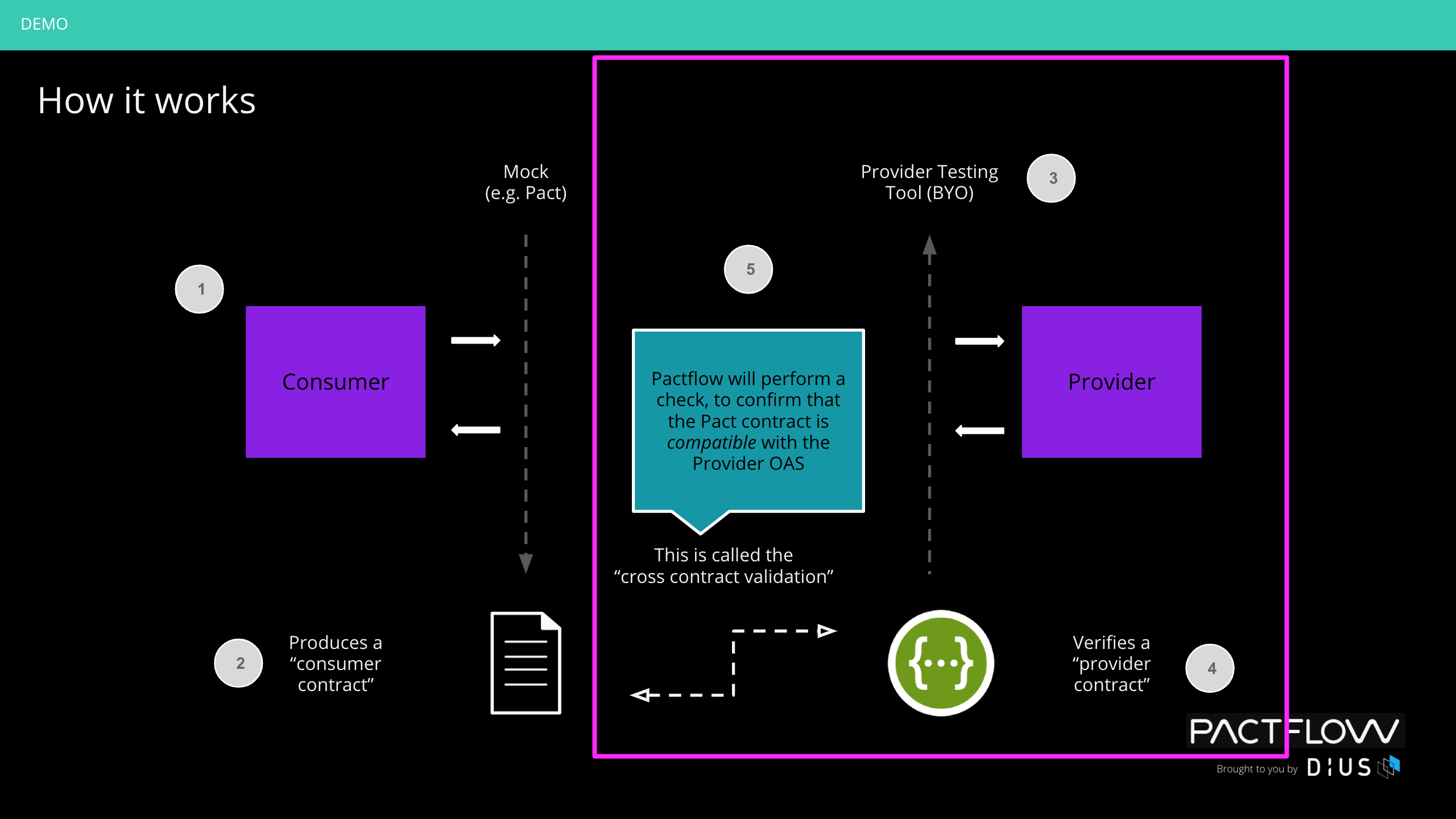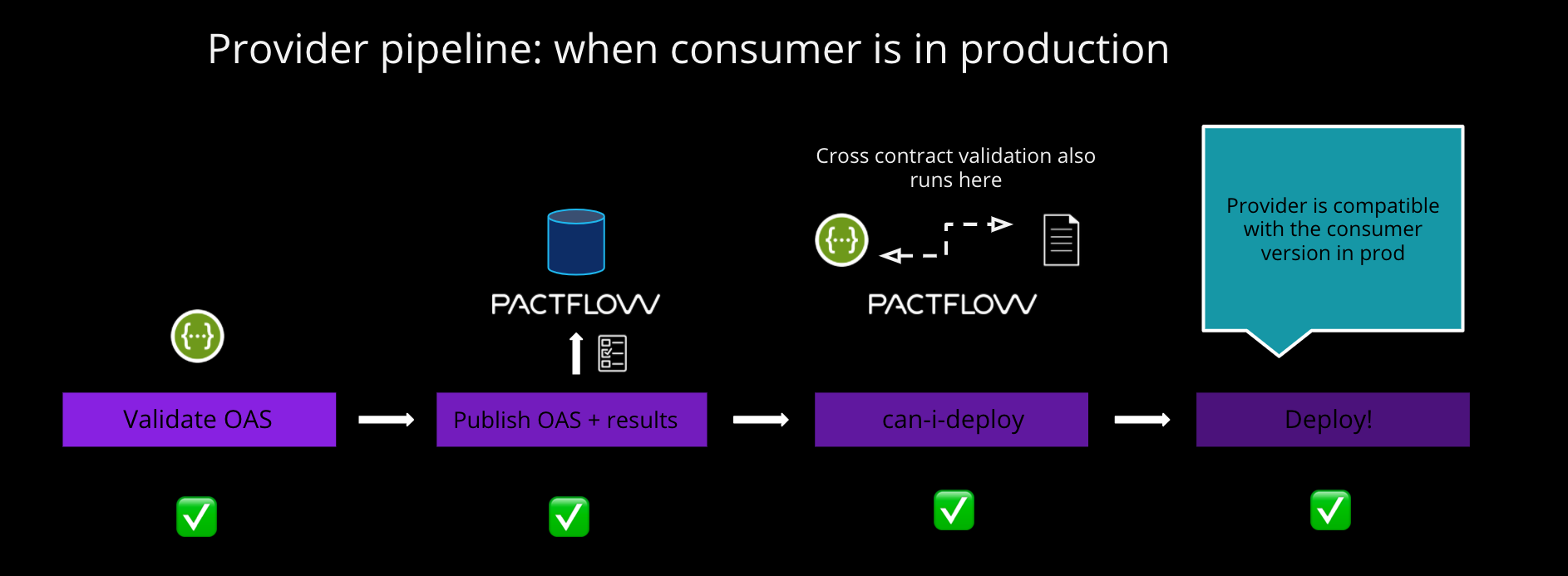Example .NET Provider - Schemathesis
Source Code
https://github.com/pactflow/example-bi-directional-provider-dotnet
Overview of Example
This is an example of a .NET "Product" API Provider that uses Schemathesis, Pact, PactFlow and GitHub Actions to generate and publish Pact provider contracts.
It performs pre-deployment cross-compatability checks to ensure that it is compatible with specified consumers using the Bi-Directional contract capability of PactFlow.
See the full PactFlow Bi-Directional Workshop for which this can be substituted in as the "provider".
Overview of Part of Bi-Directional Contract Testing Flow
In the following diagram, you can see how the provider testing process works.
When we call "can-i-deploy" the cross-contract validation process kicks off on PactFlow, to ensure any consumer consumes a valid subset of the OAS for the provider.

The project uses a Makefile to simulate a very simple build pipeline with two stages - test and deploy.
When you run the CI pipeline (see below for doing this), the pipeline should perform the following activities (simplified):
- Test
- Run tests to check spec compliance with openAPI spec
- Create branch tag via Pact CLI
- Publish openAPI spec, along with a version with the name of the current branch
- Check if we are safe to deploy to Production with
can-i-deploy(ie. has the cross-contract validation has been successfully performed)
- Deploy (only from <main|master>)
- Deploy app to Production
- Record the Production deployment in the Pact Broker

Compatible with Consumers
This project is currently compatible with the following consumers(s):
Pre-requisites
Software:
- Tools listed at: https://docs.pactflow.io/docs/workshops/ci-cd/set-up-ci/prerequisites/
- A pactflow.io account with an valid API token
Environment variables
To be able to run some of the commands locally, you will need to export the following environment variables into your shell:
PACT_BROKER_TOKEN: a valid API token for PactFlowPACT_BROKER_BASE_URL: a fully qualified domain name with protocol to your pact broker e.g. https://testdemo.pactflow.io
Usage
Steps
Make sure you have completed the pre-requisite steps of setting up your PactFlow account, and setting the environment variables
PACT_BROKER_TOKENandPACT_BROKER_BASE_URLwith the token and URL from your PactFlow account. These environment variables are what is used in the Makefile simulated build pipeline process to determine which PactFlow instance to publish to.Generate the dll for the project, this is the binary file that would be deployed to an environment. This step generates the Swagger doc for the project, which will be uploaded to PactFlow. Run the following command in the terminal on the root of the project:
make publish_dllThe project currently requires 6.0.403, you can update to your version ./global.json
Use Schemathesis to verify that the API endpoints match the generated Swagger doc by running the verify_swagger target. This will generate a a Schemathesis report documenting the compatibility of the endpoints with the Swagger doc
make verify_swaggerIf the Schemathasis test is successful run the publish_success target, this will publish the Swagger document, Schemathesis report, and success status of the verification to your PactFlow account
EXIT_CODE=0 make publish_provider_contract
Use case with Schemathesis
note - Make sure you have built the .dll first with make publish_dll
make test- run the tests locallymake fake_ci- run the CI process (the above steps) locally, this will publish the Swagger document and Schemathesis report to PactFlow.
OS/Platform specific considerations
The makefile is configured to run on Unix based systems such as you would find in most common CI/CD pipelines.
They can be run locally on Unix/Mac, or on Windows via WSL2.
Windows
To run this example on Windows, we will use Powershell and run the commands defined in the Makefile, manually.
We will take you through the steps, but you can see the commands in the ./Makefile
Some notes:
- Most of them use the pact-cli docker image
- Can be ran locally from Powershell by changing the unix paths to windows paths
- Replace the environment variable references. Any variable referenced as ${VARIABLE} can be changed to $env:VARIABLE for use in Powershell.
Click to see windows specific instructions here
Publish the example in Visual Studio, or by using the dotnet CLI to run
dotnet publishin the same directory as the example solution. This will generate a .dll and also generates the swagger doc.Next we can use Schemathesis to test the API against our generated swagger doc. Start the example project in Visual Studio or via dotnet cli from the project root:
dotnet run --project .\example-bi-directional-provider-dotnetIn powershell in the root directory (you'll need a new window if you are using dotnet CLI to run the app) use docker run to perform the Schemathesis test. This will check the API implements the swagger doc accurately and output the results to report.txt. Once this is generated the API can be shut down again
docker run --net="host" schemathesis/schemathesis:stable run --stateful=links --checks all http://host.docker.internal:9000/swagger/v1/swagger.json > report.txtNow that the Swagger doc is generated and verified the contract can be published to PactFlow. The easiest way to do this via windows is using our standalone tools. See here for cross platform instructions.
Check can-i-deploy to see if your provider contract is compatible with current consumers.
In Powershell
- set the environment variable $env:PACTICIPANT to the name of the provider in the url for step 3.
Set the environment variable $env:GIT_COMMIT to the same thing as in step 3.
This tells pactflow which provider contract and version to perform the can-i-deploy check on.
Run the can-i-deploy check using the pact-cli docker container:
docker run --rm -v <path_to_project_root>:<path_to_project_root> -e PACT_BROKER_BASE_URL -e PACT_BROKER_TOKEN pactfoundation/pact-cli broker can-i-deploy --pacticipant $env:PACTICIPANT --version $env:GIT_COMMIT --to-environment production
Caveats
Related topics / posts / discussions
- Consumer Side Bi-Directional Contract Testing Guide
- Provider Side Bi-Directional Contract Testing Guide
Found an issue?
Reach out via a GitHub Issue, or reach us over in the Pact foundation Slack